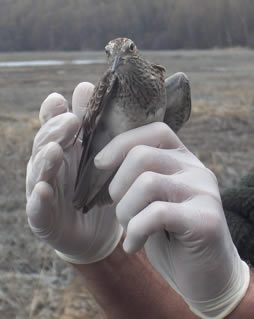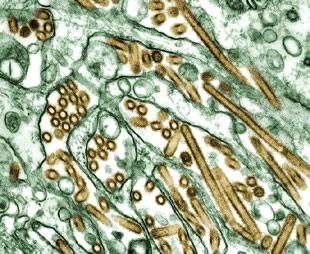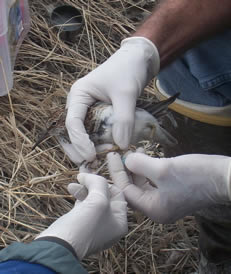
 |
University of Alaska Fairbanks stalks avian fluApril 3, 2007Courtesy of Far North Science  A pectoral sandpiper became the first bird tested for avian flu in Alaska in 2006 on the Anchorage Coastal Wildlife Refuge A pectoral sandpiper became the first bird tested for avian flu in Alaska in 2006 on the Anchorage Coastal Wildlife Refuge Credit: Doug O'Harra The study is part of a larger investigation of influenza viruses with the potential to trigger world-wide pandemics - including the deadly H5N1 avian influenza still centered in Asia and Africa. "Our initial focus is on known avian reservoirs of influenza-A viruses such as waterfowl and shorebirds," said Jonathan Runstadler, assistant professor of biology and wildlife with the Institute of Arctic Biology and the lead avian flu investigator at UAF. "However, little is known about the role of the environment and about other groups of birds in the maintenance and evolution of influenza viruses worldwide." UAF is a partner in an $18.5 million award made to the UCLA School of Public Health by the National Institutes of Health to create a regional Center for Rapid Influenza Surveillance and Research, or CRISAR, one of of six national centers getting launched this year. Under the grant, a small army of biologists and wildlife scientists will examine at least 20,000 wild animals, migrating birds and domestic stock along the Pacific Flyway of North America in Alaska, Washington and California every year. Additional work - often involving the capture of birds in nets and swabbing their anal (cloacal) cavities - will be conducted in far eastern Russia, Japan, Cambodia, Laos and Mongolia.  Electron microscope image of Avian flu Electron microscope image of Avian fluSource: CDC "We want to understand how influenza viruses evolve, adapt and are successfully transmitted in nature," said Runstadler in a release from UAF. "No one fully understands how these viruses move around between species and in our environment." After samples get sent to public health labs at UCLA, scientists will analyze the genetic code from thousands of influenza viruses each year - working with 10 times the present capacity and at far greater speeds, according to UCLA. "UCLA's School of Public Health has assembled many of our country's leading influenza experts to monitor the path of influenza in the United States and abroad," said Dr. Linda Rosenstock, dean of the school, in a release describing the project. "CRISAR will be instrumental in early detection of the next influenza outbreak, providing a head start in preventing a pandemic."  A sandpiper gets probed
A sandpiper gets probedCredit: Doug O'Harra The new project is part of a national and international effort to crack open the microscopic universe of Influenza - how the viruses evolve, how they spread from species to species, what natural reservoirs hide them in the off season. This ecological investigation has taken urgency from the nightmare strain of avian H5N1 that first appeared in 1997 in Southeast Asia. Since 2003, the bug has wiped out billions of dollars in poultry around the globe. In Southeast Asia, where many households depend on individual chicken flocks to survive, the epizootic has been devastating. In its present form, the highly pathogenic H5N1 virus doesn't easily infect people - almost all victims caught the virus directly from infected domestic fowl. But once infected, people die at alarming rates. Through April 2, this strain has killed 170 of the 288 people known to be infected in a dozen countries, according to the World Health Organization. The most recent outbreak, centered in Egypt, has killed 13 of 32 people infected. Three children were hospitalized on March 29 - a 4-year-old boy, a 7-year-old boy and a 4-year-old girl, WHO reported April 2. If a flu bug of such virulence were to mutate into a form that could pass easily from person to person, it could trigger a pandemic on the scale of the 1918 flu epidemic, which killed 50 million people worldwide and thousands in Alaska. Even if it doesn't jump to people, the virus already poses a tremendous hazard to migrating birds and North America's multi-billion-dollar poultry industry. Largely to figure out how all Influezas make their living - and partly to head off any potential pandemic - National Institute of Allergy and Infectious Diseases plans to spend $23 million per year for the next seven years to establish the six Centers of Excellence for Influenza Research and Surveillance in the United States, according to a new release. A big portion of the effort will focus on Alaska - the avian crossroads of the world with more than 450 species from six continents. "Alaska is the one place in the world where migratory birds (from both hemispheres) come together," Runstadler explains. "We potentially could have overlap of viral strains from the Americas and Asia. . It could be sort of a keystone for the virus's ecology." Scientists fear that migrating birds could bring viruses to Alaska from all over the world, allowing them to mix and match and recombine. If the highly pathogenic H5N1 arrives and gets dribbled into this viral stew, it could infect birds bound for lower North America or mutate into far deadlier forms. "Alaska is recognized as a prime location for transmission and reassortment of influenza-A virus strains between birds that migrate north from both eastern and western hemispheres," said George Happ, CRISAR co-investigator and director of the NIH IDeA Network for Biomedical Research Excellence at UA, which has supported UAF's avian influenza work since 2004.
Jonathon Runstadler Credit: IAB UAF researchers expect to collect and test 4,000 samples from Alaska and another 4,000 samples from Russia and northern Japan each year for five years beginning this May. Falk Huettmann, IAB assistant professor of wildlife ecology, will coordinate field work in Russia. Any samples that test postitive in the field will get further analysis by scientists at UCLA, UC Davis, the Wildlife Conservation Society and the Los Alamos National Laboratory. "At UAF, we will use the genetic information from UC Davis to continually refine existing studies and develop new research on the ecology of the influenza virus and the immune response of birds," Runstadler explained in the release.  Jonathon Runstadler Credit: IAB Last year, the federal government launched a national bird flu surveillance in Alaska. Scientists would swabbed the butts of some 13,651 birds in Alaska, plus tested 4,696 birds killed by hunters and 1,030 birds found dead. Another 564 samples were taken at foraging and nesting sites. Through Feb. 21, scientists at three federal departments had tested 95,131 samples taken in the United States and found no sign of deadly H5N1 strain from Asia. Only 16 birds tested positive for a low-pathenogic H5N1 virus. |
|